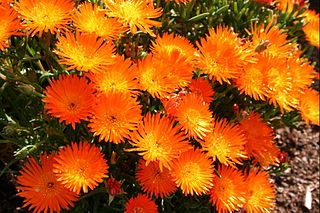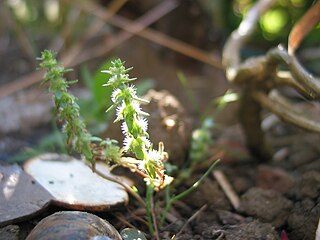
Ephedra is a medicinal preparation from the plant Ephedra sinica. Several additional species belonging to the genus Ephedra have traditionally been used for a variety of medicinal purposes, and are a possible candidate for the soma plant of Indo-Iranian religion. It has been used in traditional Chinese medicine, in which it is referred to as Ma Huang, for more than 2,000 years. Native Americans and Mormon pioneers drank a tea brewed from other Ephedra species, called "Mormon tea" and "Indian tea".

Lampranthus is a genus of succulent plants in the family Aizoaceae, indigenous to southern Africa.

Mesembrine is an alkaloid present in Sceletium tortuosum (kanna). It has been shown to act as a serotonin reuptake inhibitor (Ki = 1.4 nM), and more recently, has also been found to behave as a weak inhibitor of the enzyme phosphodiesterase 4 (PDE4) (Ki = 7,800 nM). In an in vitro study published in 2015, researchers concluded that "a high-mesembrine Sceletium extract" may exert anti-depressant effects by acting as a monoamine releasing agent." As such, mesembrine likely plays a dominant role in the antidepressant effects of kanna. The levorotatory isomer, (−)-mesembrine, is the natural form.

Drosanthemum ("dewflowers") is a genus of succulent plants in the ice plant family native to the winter-rainfall regions of southern Africa, including Namibia and the Cape Provinces and Free State of South Africa. Most species bear colorful flowers.

Mesembryanthemum cordifolium, formerly known as Aptenia cordifolia, is a species of succulent plant in the iceplant family. It is a creeping plant that forms a carpet of flat-growing perennial herbs in groups on the ground from a base. Genus name means middle-embryo flower in reference to the position of the ovary in the flower. The specific epithet is derived from Latin for heart-shaped leaves.

Conium maculatum, colloquially known as hemlock, poison hemlock or wild hemlock, is a highly poisonous biennial herbaceous flowering plant in the carrot family Apiaceae, native to Europe and North Africa. A hardy plant capable of living in a variety of environments, hemlock is widely naturalized in locations outside its native range, such as parts of Australia, West Asia, and North and South America, to which it has been introduced. It is capable of spreading and thereby becoming an invasive weed.

Mesembrenone is an alkaloid constituent of Sceletium tortuosum (Kanna) and minor constituent of Lampranthus aureus and Lampranthus spectabilis

Althaea hirsuta, the hairy marshmallow, is a species of annual herb in the family Malvaceae. They have a self-supporting growth form and simple, broad leaves. Individuals can grow to 28 cm (11 in).

Euphorbia hirsuta is a species of herb in the family Euphorbiaceae.

Frankenia hirsuta is a species of plant in the family Frankeniaceae. They have a self-supporting growth form, individuals can grow to 17 cm tall.
Hypericum australe is a species of plant in the family Hypericaceae. Individuals can grow to 24 cm tall.

Lampranthus aureus is a species of shrub in the family Aizoaceae. They are succulent plants. They have a self-supporting growth form and simple, broad leaves.

Lampranthus spectabilis, the trailing iceplant, is a species of flowering plant in the family Aizoaceae, native to the Cape Provinces of South Africa. The unimproved species and a number of cultivars are commercially available, including 'Tresco Apricot', 'Tresco Brilliant', 'Tresco Fire', 'Tresco Orange', 'Tresco Peach', 'Tresco Pearl', 'Tresco Purple', and 'Tresco Red'.
Malope malacoides is a species of plants in the family Malvaceae.

Medicago monspeliaca, the hairy medick, is a species of annual herb in the family Fabaceae. They have a self-supporting growth form and compound, broad leaves. Individuals can grow to 0.12 m.

Valantia hispida is a species of annual herb in the family Rubiaceae. They have a self-supporting growth form and simple, broad leaves. Individuals can grow to 0.05 m.

Valerianella eriocarpa is a plant species in the family Caprifoliaceae.

Orobanche pubescens is a species of annual herb in the family Orobanchaceae. They have a self-supporting growth form. Individuals can grow to 0.17 m.
Persicaria lanigera is a species of plants in the family Polygonaceae.
Plantago bellardii is a species of annual herb in the family Plantaginaceae. They have a self-supporting growth form and simple, broad leaves. Individuals can grow to 4 cm tall.
















